Knowledge Management and Information System Report for Tesco Retail
VerifiedAdded on 2023/01/12
|12
|4140
|40
Report
AI Summary
This report provides a comprehensive analysis of Tesco's knowledge management and information systems (KMIS). It begins with an overview of Tesco, followed by an evaluation of its internal capabilities using SWOT analysis and external environmental factors through PESTLE and Porter's Five Forces models. The report identifies strengths, weaknesses, opportunities, and threats. It then recommends various KMIS solutions, including document management, to enhance performance and address challenges. The report emphasizes the importance of KMIS for improving customer satisfaction, operational efficiency, and gaining a competitive edge. The report concludes with a critical assessment of the challenges Tesco may face when implementing KMIS. Overall, the report offers valuable insights into how Tesco can leverage KMIS to achieve its strategic objectives and improve its business outcomes.
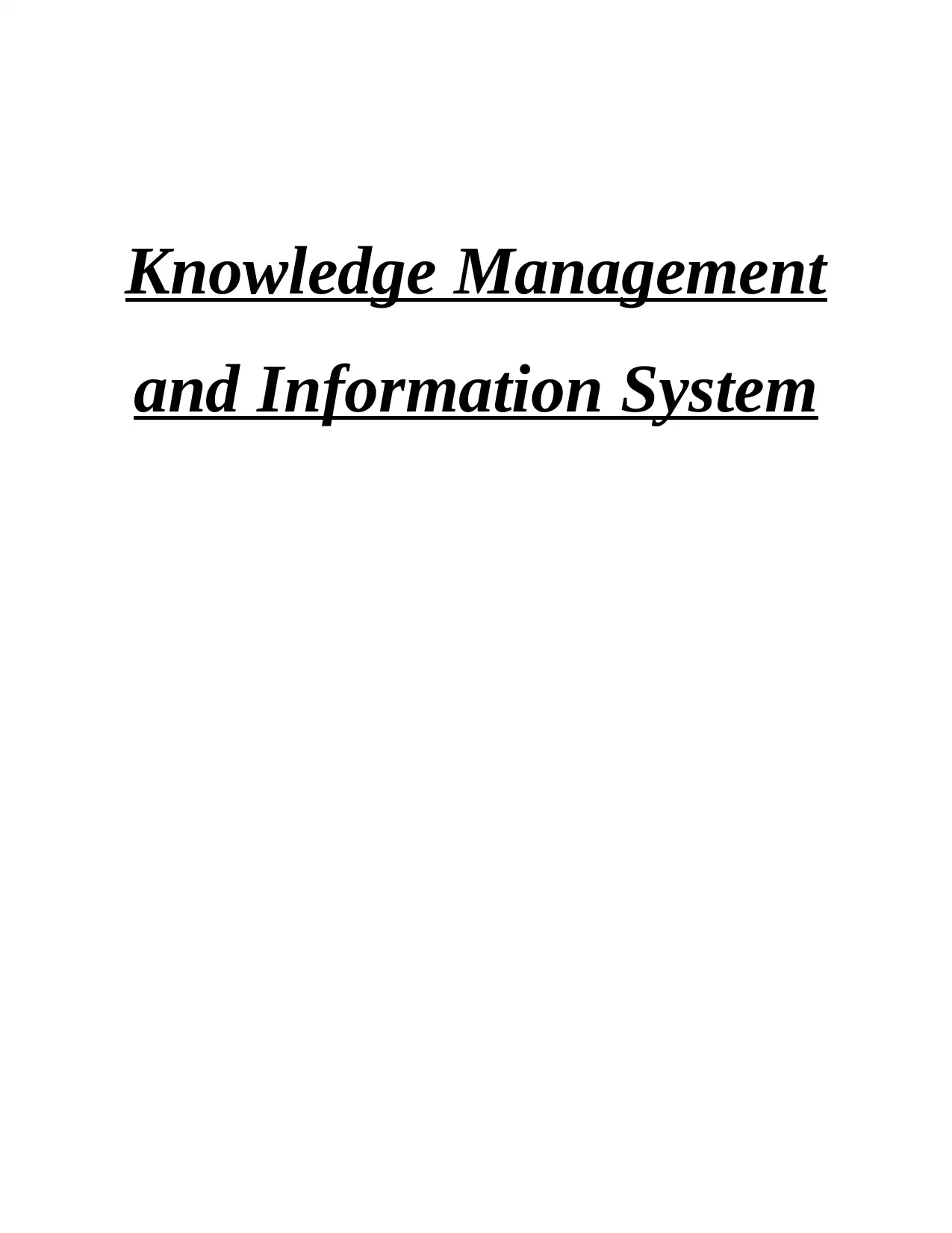
Knowledge Management
and Information System
and Information System
Paraphrase This Document
Need a fresh take? Get an instant paraphrase of this document with our AI Paraphraser
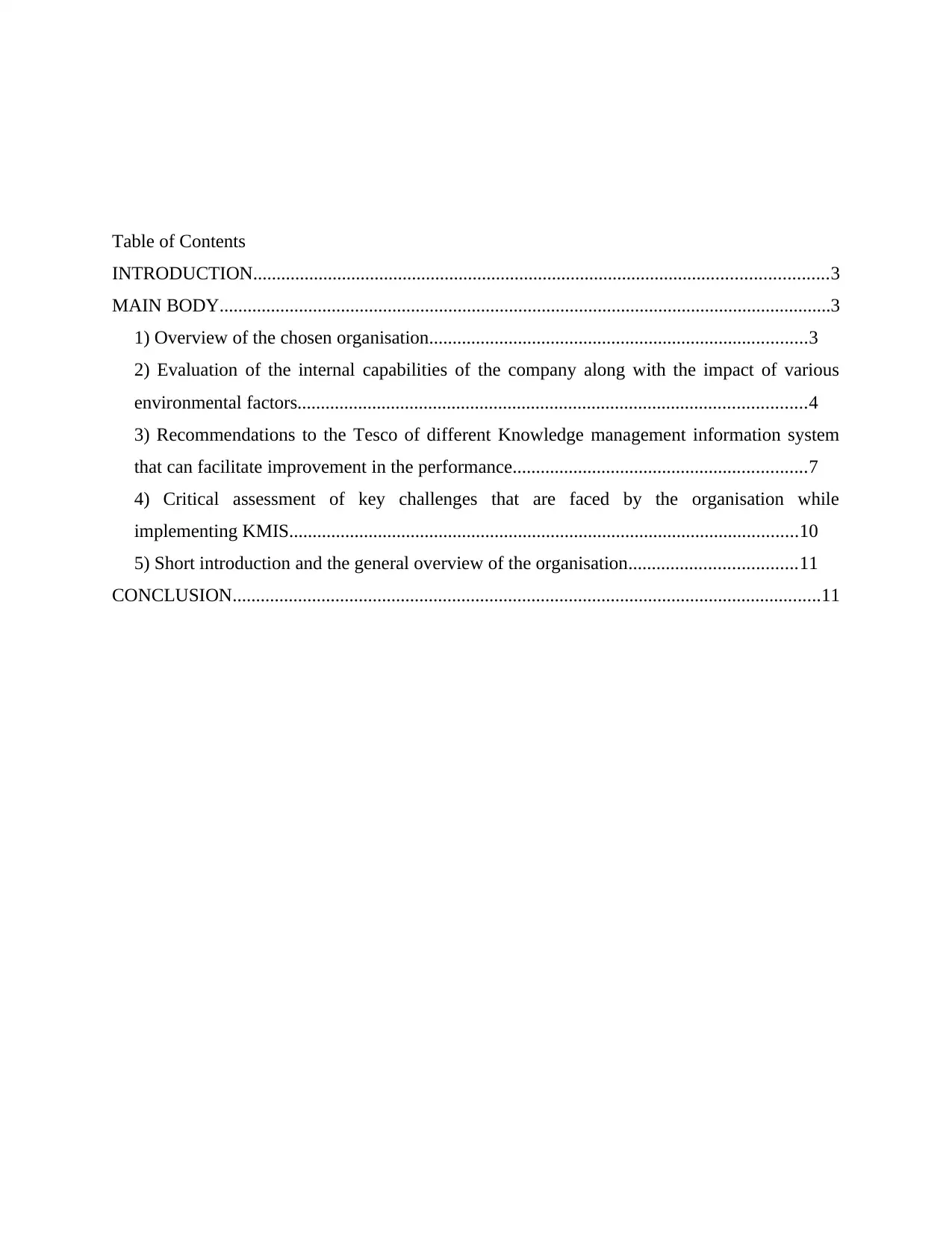
Table of Contents
INTRODUCTION...........................................................................................................................3
MAIN BODY...................................................................................................................................3
1) Overview of the chosen organisation.................................................................................3
2) Evaluation of the internal capabilities of the company along with the impact of various
environmental factors.............................................................................................................4
3) Recommendations to the Tesco of different Knowledge management information system
that can facilitate improvement in the performance...............................................................7
4) Critical assessment of key challenges that are faced by the organisation while
implementing KMIS.............................................................................................................10
5) Short introduction and the general overview of the organisation....................................11
CONCLUSION..............................................................................................................................11
INTRODUCTION...........................................................................................................................3
MAIN BODY...................................................................................................................................3
1) Overview of the chosen organisation.................................................................................3
2) Evaluation of the internal capabilities of the company along with the impact of various
environmental factors.............................................................................................................4
3) Recommendations to the Tesco of different Knowledge management information system
that can facilitate improvement in the performance...............................................................7
4) Critical assessment of key challenges that are faced by the organisation while
implementing KMIS.............................................................................................................10
5) Short introduction and the general overview of the organisation....................................11
CONCLUSION..............................................................................................................................11
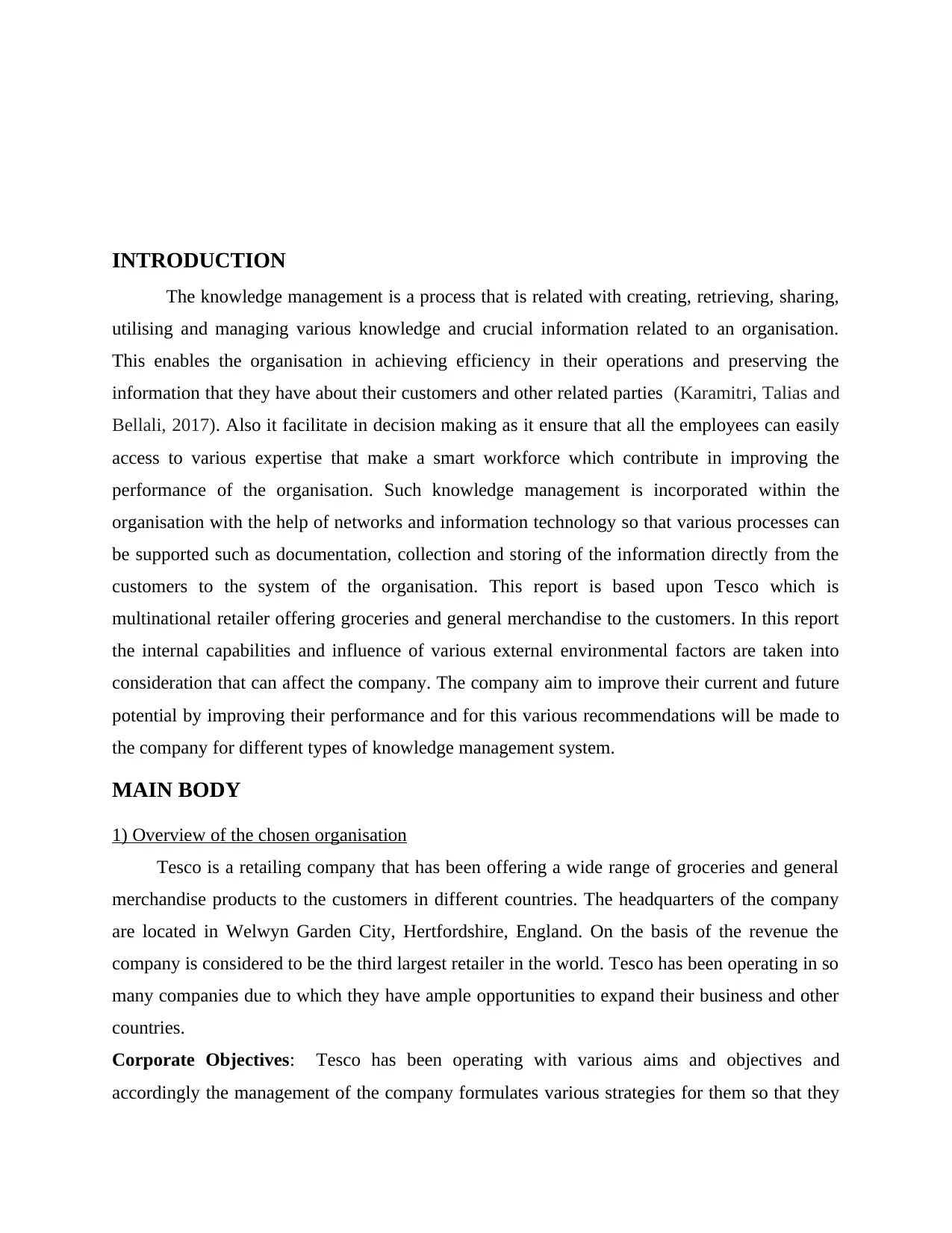
INTRODUCTION
The knowledge management is a process that is related with creating, retrieving, sharing,
utilising and managing various knowledge and crucial information related to an organisation.
This enables the organisation in achieving efficiency in their operations and preserving the
information that they have about their customers and other related parties (Karamitri, Talias and
Bellali, 2017). Also it facilitate in decision making as it ensure that all the employees can easily
access to various expertise that make a smart workforce which contribute in improving the
performance of the organisation. Such knowledge management is incorporated within the
organisation with the help of networks and information technology so that various processes can
be supported such as documentation, collection and storing of the information directly from the
customers to the system of the organisation. This report is based upon Tesco which is
multinational retailer offering groceries and general merchandise to the customers. In this report
the internal capabilities and influence of various external environmental factors are taken into
consideration that can affect the company. The company aim to improve their current and future
potential by improving their performance and for this various recommendations will be made to
the company for different types of knowledge management system.
MAIN BODY
1) Overview of the chosen organisation
Tesco is a retailing company that has been offering a wide range of groceries and general
merchandise products to the customers in different countries. The headquarters of the company
are located in Welwyn Garden City, Hertfordshire, England. On the basis of the revenue the
company is considered to be the third largest retailer in the world. Tesco has been operating in so
many companies due to which they have ample opportunities to expand their business and other
countries.
Corporate Objectives: Tesco has been operating with various aims and objectives and
accordingly the management of the company formulates various strategies for them so that they
The knowledge management is a process that is related with creating, retrieving, sharing,
utilising and managing various knowledge and crucial information related to an organisation.
This enables the organisation in achieving efficiency in their operations and preserving the
information that they have about their customers and other related parties (Karamitri, Talias and
Bellali, 2017). Also it facilitate in decision making as it ensure that all the employees can easily
access to various expertise that make a smart workforce which contribute in improving the
performance of the organisation. Such knowledge management is incorporated within the
organisation with the help of networks and information technology so that various processes can
be supported such as documentation, collection and storing of the information directly from the
customers to the system of the organisation. This report is based upon Tesco which is
multinational retailer offering groceries and general merchandise to the customers. In this report
the internal capabilities and influence of various external environmental factors are taken into
consideration that can affect the company. The company aim to improve their current and future
potential by improving their performance and for this various recommendations will be made to
the company for different types of knowledge management system.
MAIN BODY
1) Overview of the chosen organisation
Tesco is a retailing company that has been offering a wide range of groceries and general
merchandise products to the customers in different countries. The headquarters of the company
are located in Welwyn Garden City, Hertfordshire, England. On the basis of the revenue the
company is considered to be the third largest retailer in the world. Tesco has been operating in so
many companies due to which they have ample opportunities to expand their business and other
countries.
Corporate Objectives: Tesco has been operating with various aims and objectives and
accordingly the management of the company formulates various strategies for them so that they
⊘ This is a preview!⊘
Do you want full access?
Subscribe today to unlock all pages.

Trusted by 1+ million students worldwide
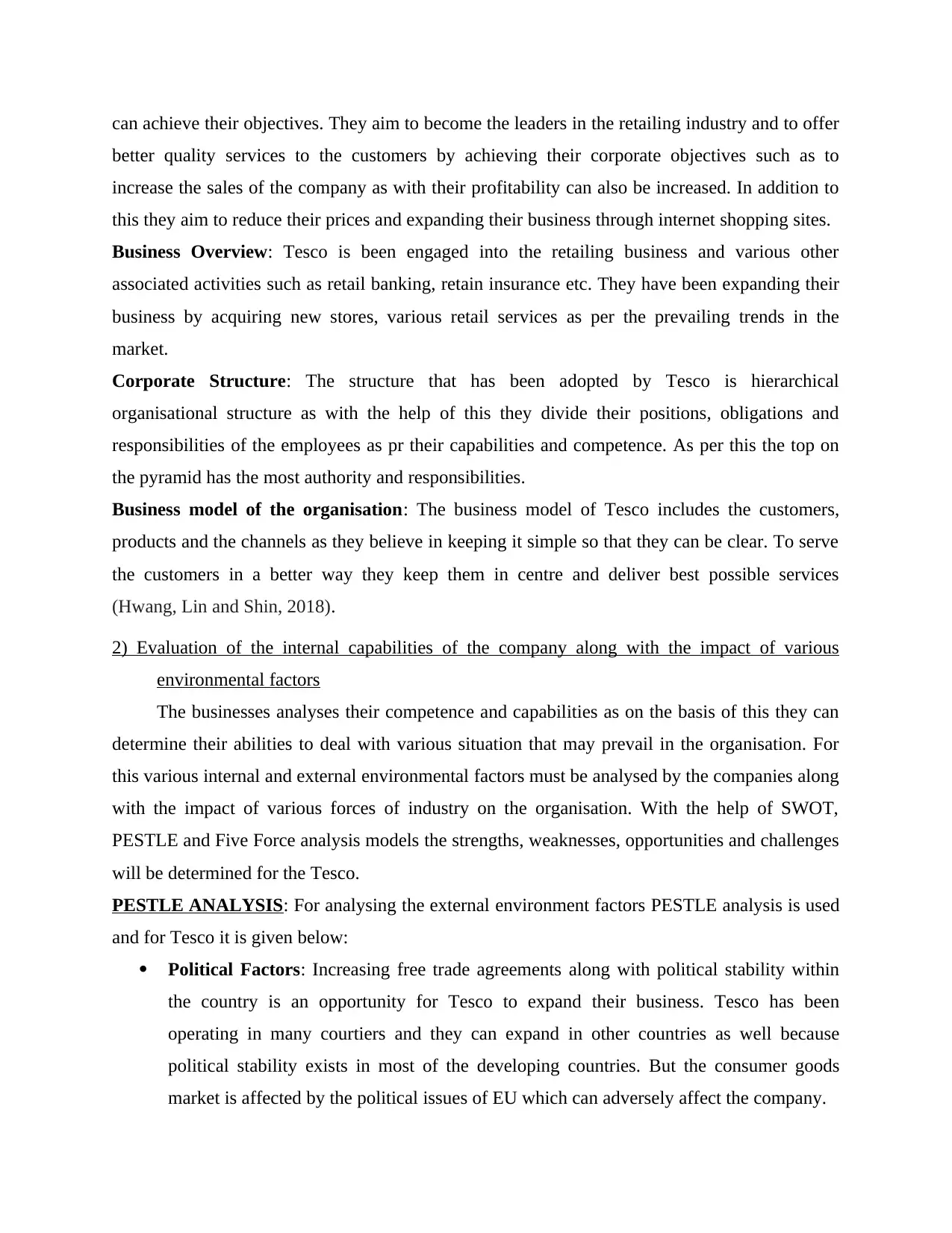
can achieve their objectives. They aim to become the leaders in the retailing industry and to offer
better quality services to the customers by achieving their corporate objectives such as to
increase the sales of the company as with their profitability can also be increased. In addition to
this they aim to reduce their prices and expanding their business through internet shopping sites.
Business Overview: Tesco is been engaged into the retailing business and various other
associated activities such as retail banking, retain insurance etc. They have been expanding their
business by acquiring new stores, various retail services as per the prevailing trends in the
market.
Corporate Structure: The structure that has been adopted by Tesco is hierarchical
organisational structure as with the help of this they divide their positions, obligations and
responsibilities of the employees as pr their capabilities and competence. As per this the top on
the pyramid has the most authority and responsibilities.
Business model of the organisation: The business model of Tesco includes the customers,
products and the channels as they believe in keeping it simple so that they can be clear. To serve
the customers in a better way they keep them in centre and deliver best possible services
(Hwang, Lin and Shin, 2018).
2) Evaluation of the internal capabilities of the company along with the impact of various
environmental factors
The businesses analyses their competence and capabilities as on the basis of this they can
determine their abilities to deal with various situation that may prevail in the organisation. For
this various internal and external environmental factors must be analysed by the companies along
with the impact of various forces of industry on the organisation. With the help of SWOT,
PESTLE and Five Force analysis models the strengths, weaknesses, opportunities and challenges
will be determined for the Tesco.
PESTLE ANALYSIS: For analysing the external environment factors PESTLE analysis is used
and for Tesco it is given below:
Political Factors: Increasing free trade agreements along with political stability within
the country is an opportunity for Tesco to expand their business. Tesco has been
operating in many courtiers and they can expand in other countries as well because
political stability exists in most of the developing countries. But the consumer goods
market is affected by the political issues of EU which can adversely affect the company.
better quality services to the customers by achieving their corporate objectives such as to
increase the sales of the company as with their profitability can also be increased. In addition to
this they aim to reduce their prices and expanding their business through internet shopping sites.
Business Overview: Tesco is been engaged into the retailing business and various other
associated activities such as retail banking, retain insurance etc. They have been expanding their
business by acquiring new stores, various retail services as per the prevailing trends in the
market.
Corporate Structure: The structure that has been adopted by Tesco is hierarchical
organisational structure as with the help of this they divide their positions, obligations and
responsibilities of the employees as pr their capabilities and competence. As per this the top on
the pyramid has the most authority and responsibilities.
Business model of the organisation: The business model of Tesco includes the customers,
products and the channels as they believe in keeping it simple so that they can be clear. To serve
the customers in a better way they keep them in centre and deliver best possible services
(Hwang, Lin and Shin, 2018).
2) Evaluation of the internal capabilities of the company along with the impact of various
environmental factors
The businesses analyses their competence and capabilities as on the basis of this they can
determine their abilities to deal with various situation that may prevail in the organisation. For
this various internal and external environmental factors must be analysed by the companies along
with the impact of various forces of industry on the organisation. With the help of SWOT,
PESTLE and Five Force analysis models the strengths, weaknesses, opportunities and challenges
will be determined for the Tesco.
PESTLE ANALYSIS: For analysing the external environment factors PESTLE analysis is used
and for Tesco it is given below:
Political Factors: Increasing free trade agreements along with political stability within
the country is an opportunity for Tesco to expand their business. Tesco has been
operating in many courtiers and they can expand in other countries as well because
political stability exists in most of the developing countries. But the consumer goods
market is affected by the political issues of EU which can adversely affect the company.
Paraphrase This Document
Need a fresh take? Get an instant paraphrase of this document with our AI Paraphraser
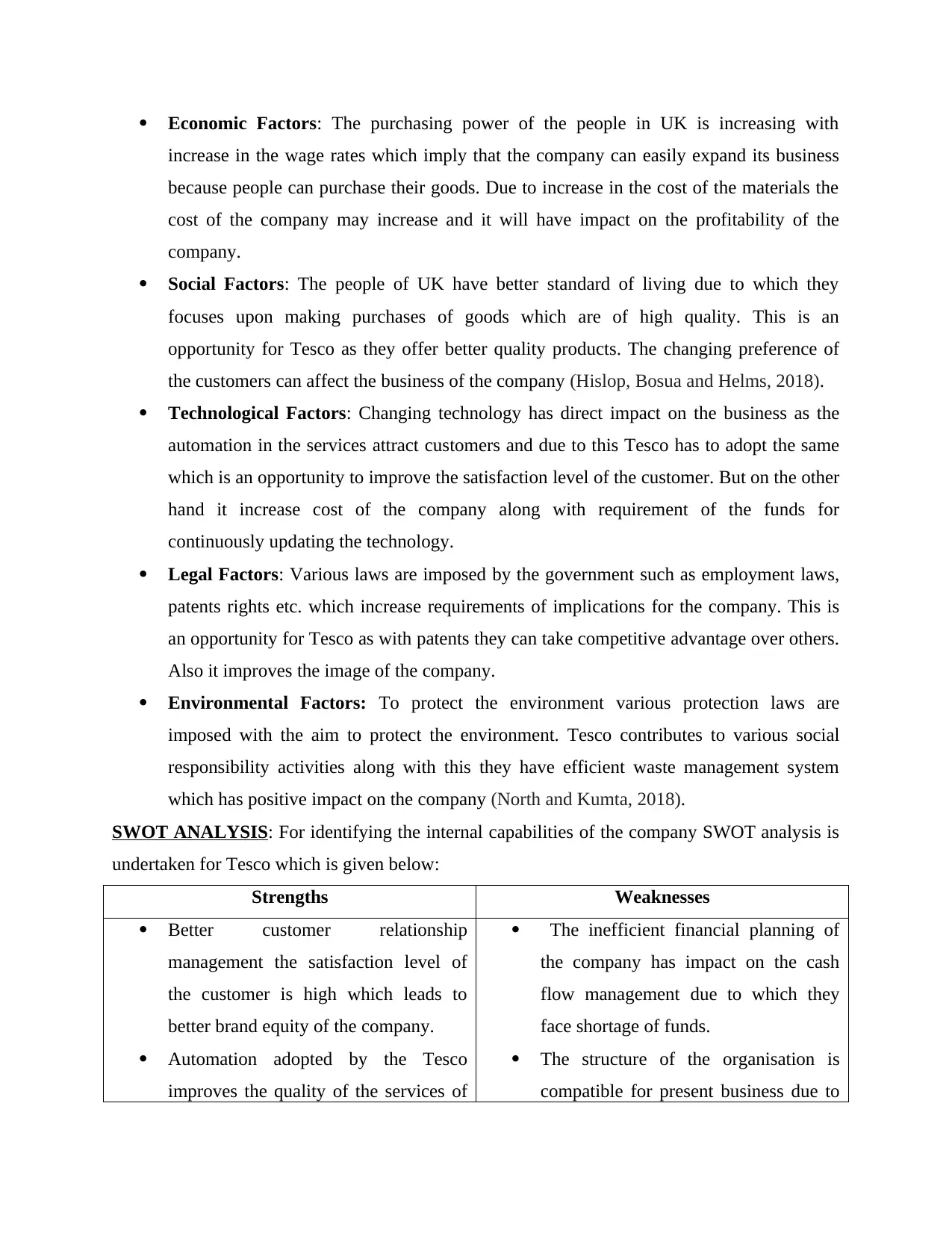
Economic Factors: The purchasing power of the people in UK is increasing with
increase in the wage rates which imply that the company can easily expand its business
because people can purchase their goods. Due to increase in the cost of the materials the
cost of the company may increase and it will have impact on the profitability of the
company.
Social Factors: The people of UK have better standard of living due to which they
focuses upon making purchases of goods which are of high quality. This is an
opportunity for Tesco as they offer better quality products. The changing preference of
the customers can affect the business of the company (Hislop, Bosua and Helms, 2018).
Technological Factors: Changing technology has direct impact on the business as the
automation in the services attract customers and due to this Tesco has to adopt the same
which is an opportunity to improve the satisfaction level of the customer. But on the other
hand it increase cost of the company along with requirement of the funds for
continuously updating the technology.
Legal Factors: Various laws are imposed by the government such as employment laws,
patents rights etc. which increase requirements of implications for the company. This is
an opportunity for Tesco as with patents they can take competitive advantage over others.
Also it improves the image of the company.
Environmental Factors: To protect the environment various protection laws are
imposed with the aim to protect the environment. Tesco contributes to various social
responsibility activities along with this they have efficient waste management system
which has positive impact on the company (North and Kumta, 2018).
SWOT ANALYSIS: For identifying the internal capabilities of the company SWOT analysis is
undertaken for Tesco which is given below:
Strengths Weaknesses
Better customer relationship
management the satisfaction level of
the customer is high which leads to
better brand equity of the company.
Automation adopted by the Tesco
improves the quality of the services of
The inefficient financial planning of
the company has impact on the cash
flow management due to which they
face shortage of funds.
The structure of the organisation is
compatible for present business due to
increase in the wage rates which imply that the company can easily expand its business
because people can purchase their goods. Due to increase in the cost of the materials the
cost of the company may increase and it will have impact on the profitability of the
company.
Social Factors: The people of UK have better standard of living due to which they
focuses upon making purchases of goods which are of high quality. This is an
opportunity for Tesco as they offer better quality products. The changing preference of
the customers can affect the business of the company (Hislop, Bosua and Helms, 2018).
Technological Factors: Changing technology has direct impact on the business as the
automation in the services attract customers and due to this Tesco has to adopt the same
which is an opportunity to improve the satisfaction level of the customer. But on the other
hand it increase cost of the company along with requirement of the funds for
continuously updating the technology.
Legal Factors: Various laws are imposed by the government such as employment laws,
patents rights etc. which increase requirements of implications for the company. This is
an opportunity for Tesco as with patents they can take competitive advantage over others.
Also it improves the image of the company.
Environmental Factors: To protect the environment various protection laws are
imposed with the aim to protect the environment. Tesco contributes to various social
responsibility activities along with this they have efficient waste management system
which has positive impact on the company (North and Kumta, 2018).
SWOT ANALYSIS: For identifying the internal capabilities of the company SWOT analysis is
undertaken for Tesco which is given below:
Strengths Weaknesses
Better customer relationship
management the satisfaction level of
the customer is high which leads to
better brand equity of the company.
Automation adopted by the Tesco
improves the quality of the services of
The inefficient financial planning of
the company has impact on the cash
flow management due to which they
face shortage of funds.
The structure of the organisation is
compatible for present business due to
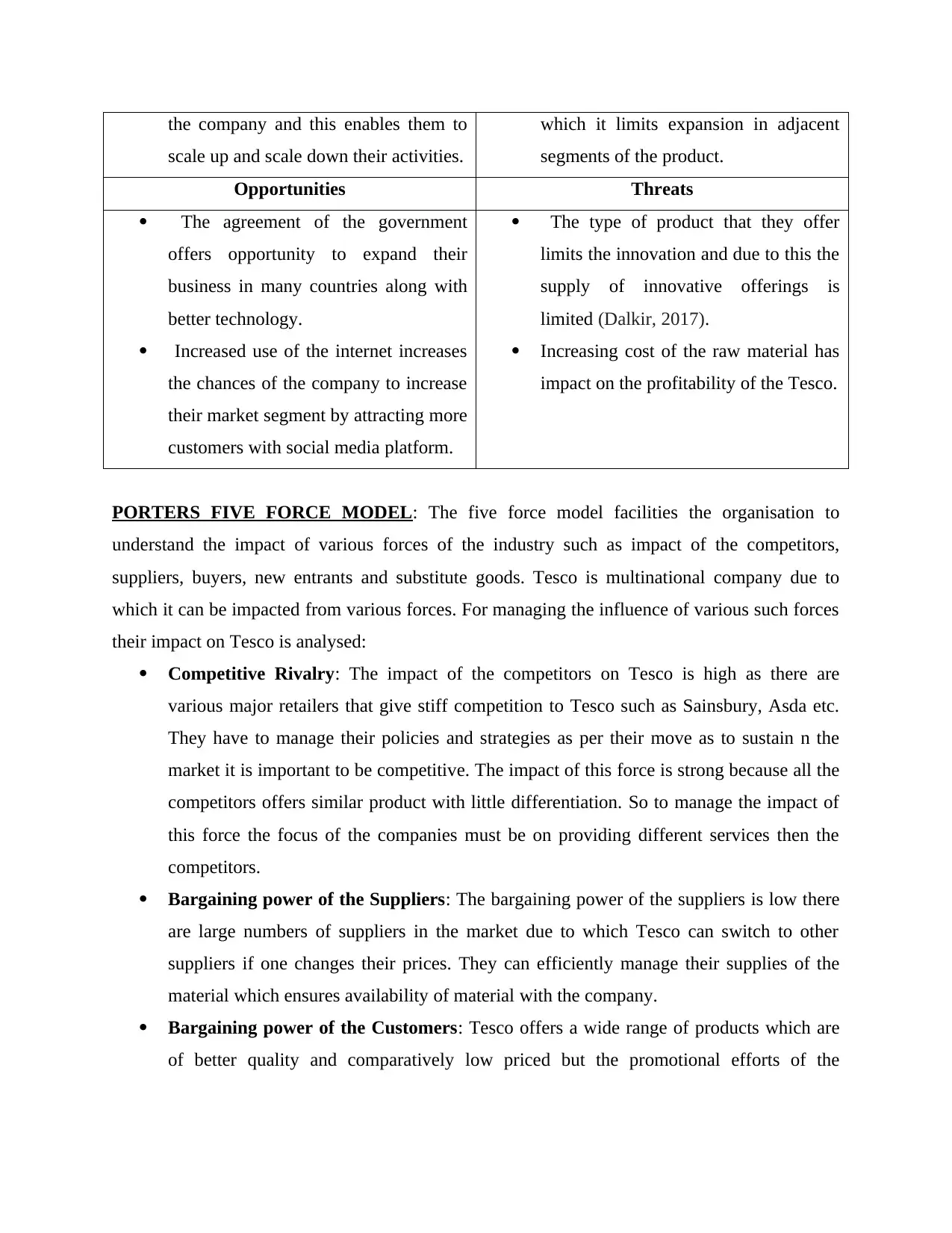
the company and this enables them to
scale up and scale down their activities.
which it limits expansion in adjacent
segments of the product.
Opportunities Threats
The agreement of the government
offers opportunity to expand their
business in many countries along with
better technology.
Increased use of the internet increases
the chances of the company to increase
their market segment by attracting more
customers with social media platform.
The type of product that they offer
limits the innovation and due to this the
supply of innovative offerings is
limited (Dalkir, 2017).
Increasing cost of the raw material has
impact on the profitability of the Tesco.
PORTERS FIVE FORCE MODEL: The five force model facilities the organisation to
understand the impact of various forces of the industry such as impact of the competitors,
suppliers, buyers, new entrants and substitute goods. Tesco is multinational company due to
which it can be impacted from various forces. For managing the influence of various such forces
their impact on Tesco is analysed:
Competitive Rivalry: The impact of the competitors on Tesco is high as there are
various major retailers that give stiff competition to Tesco such as Sainsbury, Asda etc.
They have to manage their policies and strategies as per their move as to sustain n the
market it is important to be competitive. The impact of this force is strong because all the
competitors offers similar product with little differentiation. So to manage the impact of
this force the focus of the companies must be on providing different services then the
competitors.
Bargaining power of the Suppliers: The bargaining power of the suppliers is low there
are large numbers of suppliers in the market due to which Tesco can switch to other
suppliers if one changes their prices. They can efficiently manage their supplies of the
material which ensures availability of material with the company.
Bargaining power of the Customers: Tesco offers a wide range of products which are
of better quality and comparatively low priced but the promotional efforts of the
scale up and scale down their activities.
which it limits expansion in adjacent
segments of the product.
Opportunities Threats
The agreement of the government
offers opportunity to expand their
business in many countries along with
better technology.
Increased use of the internet increases
the chances of the company to increase
their market segment by attracting more
customers with social media platform.
The type of product that they offer
limits the innovation and due to this the
supply of innovative offerings is
limited (Dalkir, 2017).
Increasing cost of the raw material has
impact on the profitability of the Tesco.
PORTERS FIVE FORCE MODEL: The five force model facilities the organisation to
understand the impact of various forces of the industry such as impact of the competitors,
suppliers, buyers, new entrants and substitute goods. Tesco is multinational company due to
which it can be impacted from various forces. For managing the influence of various such forces
their impact on Tesco is analysed:
Competitive Rivalry: The impact of the competitors on Tesco is high as there are
various major retailers that give stiff competition to Tesco such as Sainsbury, Asda etc.
They have to manage their policies and strategies as per their move as to sustain n the
market it is important to be competitive. The impact of this force is strong because all the
competitors offers similar product with little differentiation. So to manage the impact of
this force the focus of the companies must be on providing different services then the
competitors.
Bargaining power of the Suppliers: The bargaining power of the suppliers is low there
are large numbers of suppliers in the market due to which Tesco can switch to other
suppliers if one changes their prices. They can efficiently manage their supplies of the
material which ensures availability of material with the company.
Bargaining power of the Customers: Tesco offers a wide range of products which are
of better quality and comparatively low priced but the promotional efforts of the
⊘ This is a preview!⊘
Do you want full access?
Subscribe today to unlock all pages.

Trusted by 1+ million students worldwide
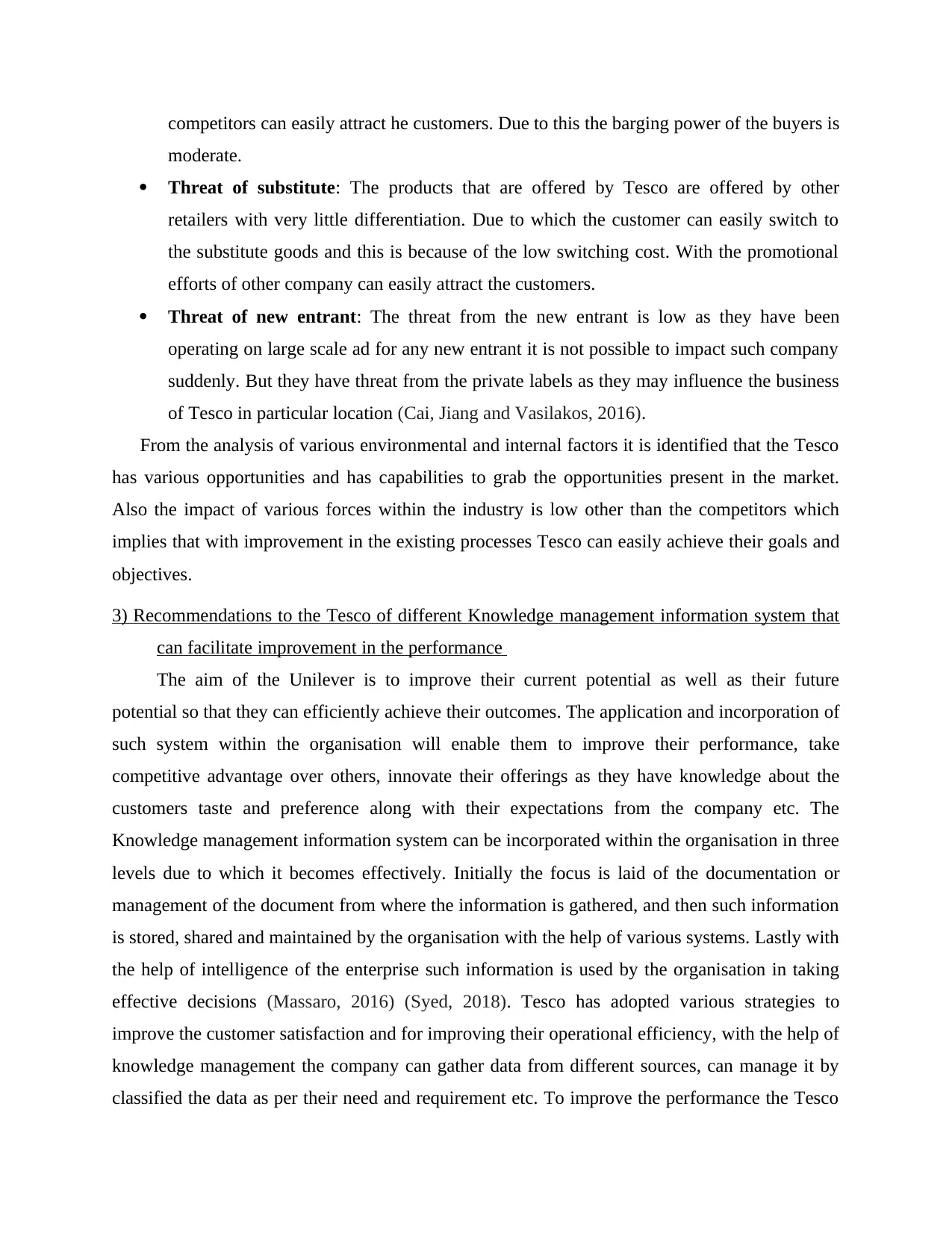
competitors can easily attract he customers. Due to this the barging power of the buyers is
moderate.
Threat of substitute: The products that are offered by Tesco are offered by other
retailers with very little differentiation. Due to which the customer can easily switch to
the substitute goods and this is because of the low switching cost. With the promotional
efforts of other company can easily attract the customers.
Threat of new entrant: The threat from the new entrant is low as they have been
operating on large scale ad for any new entrant it is not possible to impact such company
suddenly. But they have threat from the private labels as they may influence the business
of Tesco in particular location (Cai, Jiang and Vasilakos, 2016).
From the analysis of various environmental and internal factors it is identified that the Tesco
has various opportunities and has capabilities to grab the opportunities present in the market.
Also the impact of various forces within the industry is low other than the competitors which
implies that with improvement in the existing processes Tesco can easily achieve their goals and
objectives.
3) Recommendations to the Tesco of different Knowledge management information system that
can facilitate improvement in the performance
The aim of the Unilever is to improve their current potential as well as their future
potential so that they can efficiently achieve their outcomes. The application and incorporation of
such system within the organisation will enable them to improve their performance, take
competitive advantage over others, innovate their offerings as they have knowledge about the
customers taste and preference along with their expectations from the company etc. The
Knowledge management information system can be incorporated within the organisation in three
levels due to which it becomes effectively. Initially the focus is laid of the documentation or
management of the document from where the information is gathered, and then such information
is stored, shared and maintained by the organisation with the help of various systems. Lastly with
the help of intelligence of the enterprise such information is used by the organisation in taking
effective decisions (Massaro, 2016) (Syed, 2018). Tesco has adopted various strategies to
improve the customer satisfaction and for improving their operational efficiency, with the help of
knowledge management the company can gather data from different sources, can manage it by
classified the data as per their need and requirement etc. To improve the performance the Tesco
moderate.
Threat of substitute: The products that are offered by Tesco are offered by other
retailers with very little differentiation. Due to which the customer can easily switch to
the substitute goods and this is because of the low switching cost. With the promotional
efforts of other company can easily attract the customers.
Threat of new entrant: The threat from the new entrant is low as they have been
operating on large scale ad for any new entrant it is not possible to impact such company
suddenly. But they have threat from the private labels as they may influence the business
of Tesco in particular location (Cai, Jiang and Vasilakos, 2016).
From the analysis of various environmental and internal factors it is identified that the Tesco
has various opportunities and has capabilities to grab the opportunities present in the market.
Also the impact of various forces within the industry is low other than the competitors which
implies that with improvement in the existing processes Tesco can easily achieve their goals and
objectives.
3) Recommendations to the Tesco of different Knowledge management information system that
can facilitate improvement in the performance
The aim of the Unilever is to improve their current potential as well as their future
potential so that they can efficiently achieve their outcomes. The application and incorporation of
such system within the organisation will enable them to improve their performance, take
competitive advantage over others, innovate their offerings as they have knowledge about the
customers taste and preference along with their expectations from the company etc. The
Knowledge management information system can be incorporated within the organisation in three
levels due to which it becomes effectively. Initially the focus is laid of the documentation or
management of the document from where the information is gathered, and then such information
is stored, shared and maintained by the organisation with the help of various systems. Lastly with
the help of intelligence of the enterprise such information is used by the organisation in taking
effective decisions (Massaro, 2016) (Syed, 2018). Tesco has adopted various strategies to
improve the customer satisfaction and for improving their operational efficiency, with the help of
knowledge management the company can gather data from different sources, can manage it by
classified the data as per their need and requirement etc. To improve the performance the Tesco
Paraphrase This Document
Need a fresh take? Get an instant paraphrase of this document with our AI Paraphraser
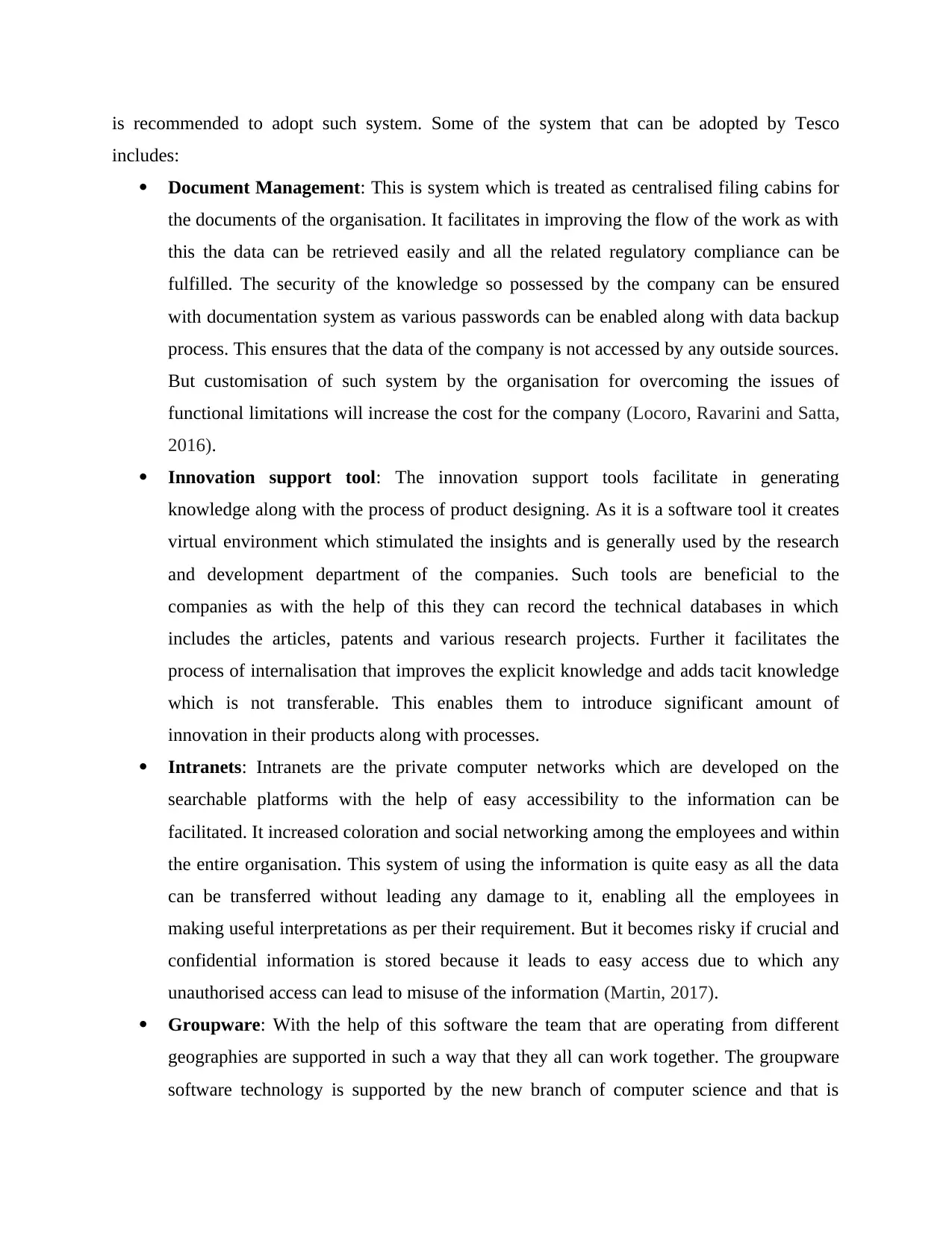
is recommended to adopt such system. Some of the system that can be adopted by Tesco
includes:
Document Management: This is system which is treated as centralised filing cabins for
the documents of the organisation. It facilitates in improving the flow of the work as with
this the data can be retrieved easily and all the related regulatory compliance can be
fulfilled. The security of the knowledge so possessed by the company can be ensured
with documentation system as various passwords can be enabled along with data backup
process. This ensures that the data of the company is not accessed by any outside sources.
But customisation of such system by the organisation for overcoming the issues of
functional limitations will increase the cost for the company (Locoro, Ravarini and Satta,
2016).
Innovation support tool: The innovation support tools facilitate in generating
knowledge along with the process of product designing. As it is a software tool it creates
virtual environment which stimulated the insights and is generally used by the research
and development department of the companies. Such tools are beneficial to the
companies as with the help of this they can record the technical databases in which
includes the articles, patents and various research projects. Further it facilitates the
process of internalisation that improves the explicit knowledge and adds tacit knowledge
which is not transferable. This enables them to introduce significant amount of
innovation in their products along with processes.
Intranets: Intranets are the private computer networks which are developed on the
searchable platforms with the help of easy accessibility to the information can be
facilitated. It increased coloration and social networking among the employees and within
the entire organisation. This system of using the information is quite easy as all the data
can be transferred without leading any damage to it, enabling all the employees in
making useful interpretations as per their requirement. But it becomes risky if crucial and
confidential information is stored because it leads to easy access due to which any
unauthorised access can lead to misuse of the information (Martin, 2017).
Groupware: With the help of this software the team that are operating from different
geographies are supported in such a way that they all can work together. The groupware
software technology is supported by the new branch of computer science and that is
includes:
Document Management: This is system which is treated as centralised filing cabins for
the documents of the organisation. It facilitates in improving the flow of the work as with
this the data can be retrieved easily and all the related regulatory compliance can be
fulfilled. The security of the knowledge so possessed by the company can be ensured
with documentation system as various passwords can be enabled along with data backup
process. This ensures that the data of the company is not accessed by any outside sources.
But customisation of such system by the organisation for overcoming the issues of
functional limitations will increase the cost for the company (Locoro, Ravarini and Satta,
2016).
Innovation support tool: The innovation support tools facilitate in generating
knowledge along with the process of product designing. As it is a software tool it creates
virtual environment which stimulated the insights and is generally used by the research
and development department of the companies. Such tools are beneficial to the
companies as with the help of this they can record the technical databases in which
includes the articles, patents and various research projects. Further it facilitates the
process of internalisation that improves the explicit knowledge and adds tacit knowledge
which is not transferable. This enables them to introduce significant amount of
innovation in their products along with processes.
Intranets: Intranets are the private computer networks which are developed on the
searchable platforms with the help of easy accessibility to the information can be
facilitated. It increased coloration and social networking among the employees and within
the entire organisation. This system of using the information is quite easy as all the data
can be transferred without leading any damage to it, enabling all the employees in
making useful interpretations as per their requirement. But it becomes risky if crucial and
confidential information is stored because it leads to easy access due to which any
unauthorised access can lead to misuse of the information (Martin, 2017).
Groupware: With the help of this software the team that are operating from different
geographies are supported in such a way that they all can work together. The groupware
software technology is supported by the new branch of computer science and that is
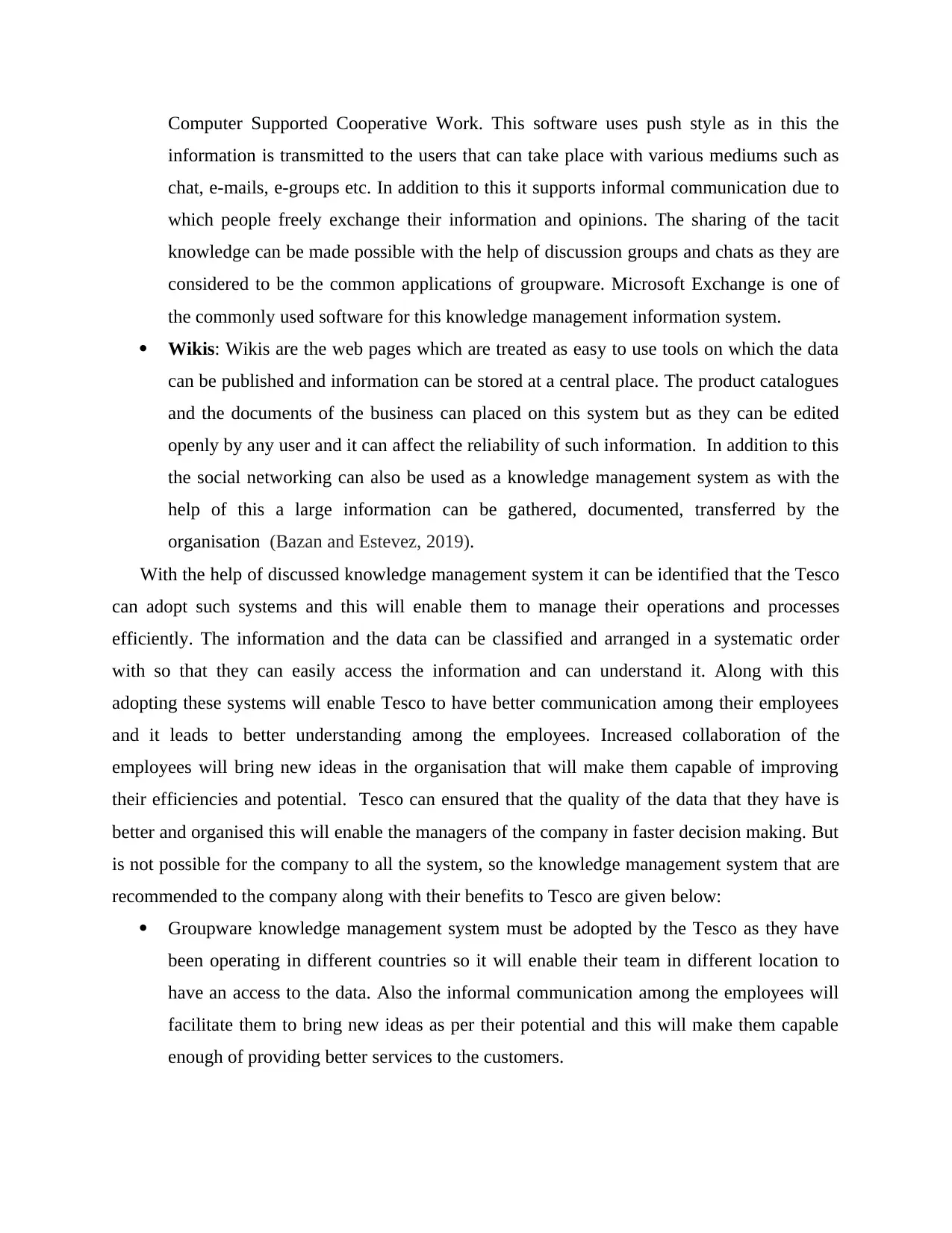
Computer Supported Cooperative Work. This software uses push style as in this the
information is transmitted to the users that can take place with various mediums such as
chat, e-mails, e-groups etc. In addition to this it supports informal communication due to
which people freely exchange their information and opinions. The sharing of the tacit
knowledge can be made possible with the help of discussion groups and chats as they are
considered to be the common applications of groupware. Microsoft Exchange is one of
the commonly used software for this knowledge management information system.
Wikis: Wikis are the web pages which are treated as easy to use tools on which the data
can be published and information can be stored at a central place. The product catalogues
and the documents of the business can placed on this system but as they can be edited
openly by any user and it can affect the reliability of such information. In addition to this
the social networking can also be used as a knowledge management system as with the
help of this a large information can be gathered, documented, transferred by the
organisation (Bazan and Estevez, 2019).
With the help of discussed knowledge management system it can be identified that the Tesco
can adopt such systems and this will enable them to manage their operations and processes
efficiently. The information and the data can be classified and arranged in a systematic order
with so that they can easily access the information and can understand it. Along with this
adopting these systems will enable Tesco to have better communication among their employees
and it leads to better understanding among the employees. Increased collaboration of the
employees will bring new ideas in the organisation that will make them capable of improving
their efficiencies and potential. Tesco can ensured that the quality of the data that they have is
better and organised this will enable the managers of the company in faster decision making. But
is not possible for the company to all the system, so the knowledge management system that are
recommended to the company along with their benefits to Tesco are given below:
Groupware knowledge management system must be adopted by the Tesco as they have
been operating in different countries so it will enable their team in different location to
have an access to the data. Also the informal communication among the employees will
facilitate them to bring new ideas as per their potential and this will make them capable
enough of providing better services to the customers.
information is transmitted to the users that can take place with various mediums such as
chat, e-mails, e-groups etc. In addition to this it supports informal communication due to
which people freely exchange their information and opinions. The sharing of the tacit
knowledge can be made possible with the help of discussion groups and chats as they are
considered to be the common applications of groupware. Microsoft Exchange is one of
the commonly used software for this knowledge management information system.
Wikis: Wikis are the web pages which are treated as easy to use tools on which the data
can be published and information can be stored at a central place. The product catalogues
and the documents of the business can placed on this system but as they can be edited
openly by any user and it can affect the reliability of such information. In addition to this
the social networking can also be used as a knowledge management system as with the
help of this a large information can be gathered, documented, transferred by the
organisation (Bazan and Estevez, 2019).
With the help of discussed knowledge management system it can be identified that the Tesco
can adopt such systems and this will enable them to manage their operations and processes
efficiently. The information and the data can be classified and arranged in a systematic order
with so that they can easily access the information and can understand it. Along with this
adopting these systems will enable Tesco to have better communication among their employees
and it leads to better understanding among the employees. Increased collaboration of the
employees will bring new ideas in the organisation that will make them capable of improving
their efficiencies and potential. Tesco can ensured that the quality of the data that they have is
better and organised this will enable the managers of the company in faster decision making. But
is not possible for the company to all the system, so the knowledge management system that are
recommended to the company along with their benefits to Tesco are given below:
Groupware knowledge management system must be adopted by the Tesco as they have
been operating in different countries so it will enable their team in different location to
have an access to the data. Also the informal communication among the employees will
facilitate them to bring new ideas as per their potential and this will make them capable
enough of providing better services to the customers.
⊘ This is a preview!⊘
Do you want full access?
Subscribe today to unlock all pages.

Trusted by 1+ million students worldwide
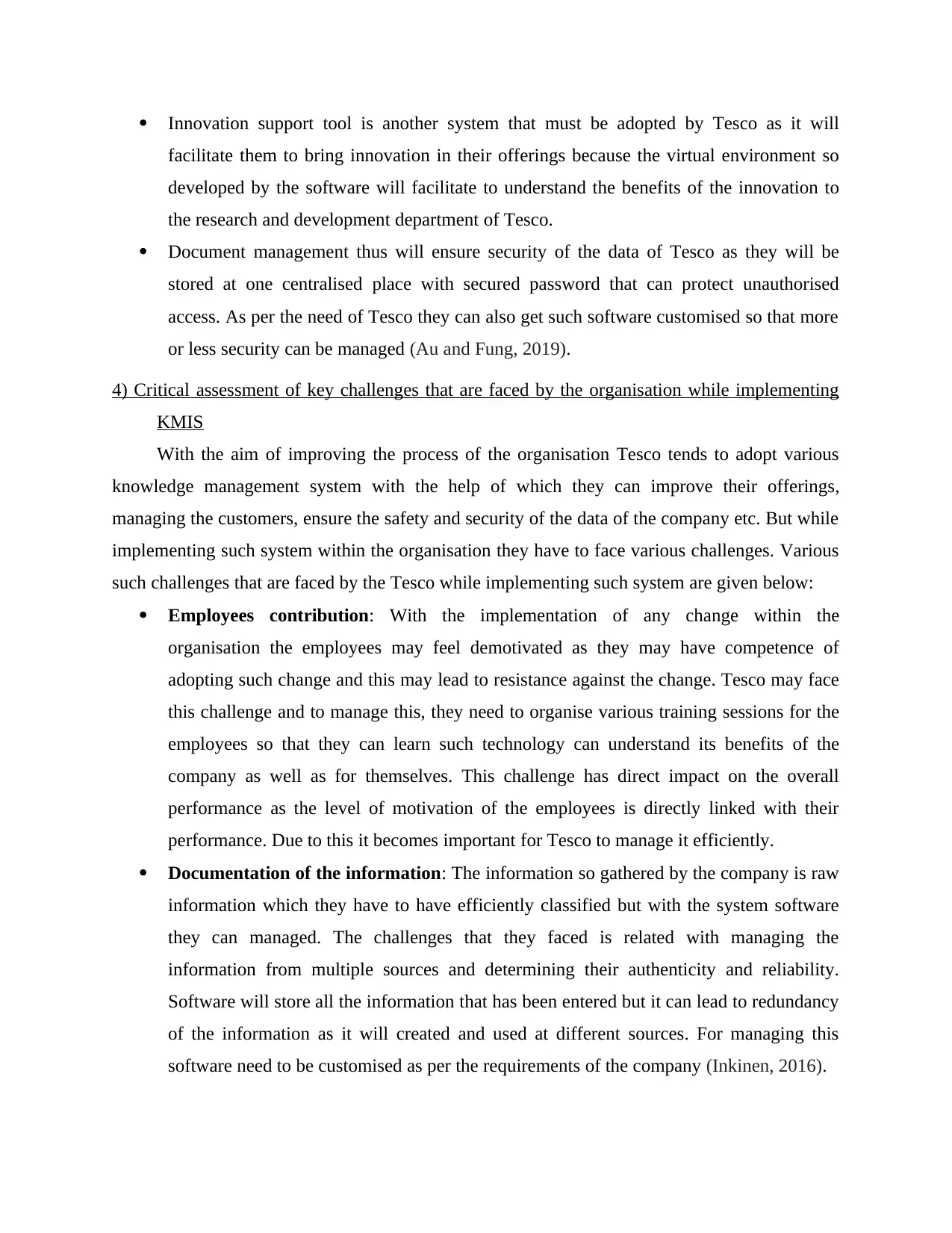
Innovation support tool is another system that must be adopted by Tesco as it will
facilitate them to bring innovation in their offerings because the virtual environment so
developed by the software will facilitate to understand the benefits of the innovation to
the research and development department of Tesco.
Document management thus will ensure security of the data of Tesco as they will be
stored at one centralised place with secured password that can protect unauthorised
access. As per the need of Tesco they can also get such software customised so that more
or less security can be managed (Au and Fung, 2019).
4) Critical assessment of key challenges that are faced by the organisation while implementing
KMIS
With the aim of improving the process of the organisation Tesco tends to adopt various
knowledge management system with the help of which they can improve their offerings,
managing the customers, ensure the safety and security of the data of the company etc. But while
implementing such system within the organisation they have to face various challenges. Various
such challenges that are faced by the Tesco while implementing such system are given below:
Employees contribution: With the implementation of any change within the
organisation the employees may feel demotivated as they may have competence of
adopting such change and this may lead to resistance against the change. Tesco may face
this challenge and to manage this, they need to organise various training sessions for the
employees so that they can learn such technology can understand its benefits of the
company as well as for themselves. This challenge has direct impact on the overall
performance as the level of motivation of the employees is directly linked with their
performance. Due to this it becomes important for Tesco to manage it efficiently.
Documentation of the information: The information so gathered by the company is raw
information which they have to have efficiently classified but with the system software
they can managed. The challenges that they faced is related with managing the
information from multiple sources and determining their authenticity and reliability.
Software will store all the information that has been entered but it can lead to redundancy
of the information as it will created and used at different sources. For managing this
software need to be customised as per the requirements of the company (Inkinen, 2016).
facilitate them to bring innovation in their offerings because the virtual environment so
developed by the software will facilitate to understand the benefits of the innovation to
the research and development department of Tesco.
Document management thus will ensure security of the data of Tesco as they will be
stored at one centralised place with secured password that can protect unauthorised
access. As per the need of Tesco they can also get such software customised so that more
or less security can be managed (Au and Fung, 2019).
4) Critical assessment of key challenges that are faced by the organisation while implementing
KMIS
With the aim of improving the process of the organisation Tesco tends to adopt various
knowledge management system with the help of which they can improve their offerings,
managing the customers, ensure the safety and security of the data of the company etc. But while
implementing such system within the organisation they have to face various challenges. Various
such challenges that are faced by the Tesco while implementing such system are given below:
Employees contribution: With the implementation of any change within the
organisation the employees may feel demotivated as they may have competence of
adopting such change and this may lead to resistance against the change. Tesco may face
this challenge and to manage this, they need to organise various training sessions for the
employees so that they can learn such technology can understand its benefits of the
company as well as for themselves. This challenge has direct impact on the overall
performance as the level of motivation of the employees is directly linked with their
performance. Due to this it becomes important for Tesco to manage it efficiently.
Documentation of the information: The information so gathered by the company is raw
information which they have to have efficiently classified but with the system software
they can managed. The challenges that they faced is related with managing the
information from multiple sources and determining their authenticity and reliability.
Software will store all the information that has been entered but it can lead to redundancy
of the information as it will created and used at different sources. For managing this
software need to be customised as per the requirements of the company (Inkinen, 2016).
Paraphrase This Document
Need a fresh take? Get an instant paraphrase of this document with our AI Paraphraser
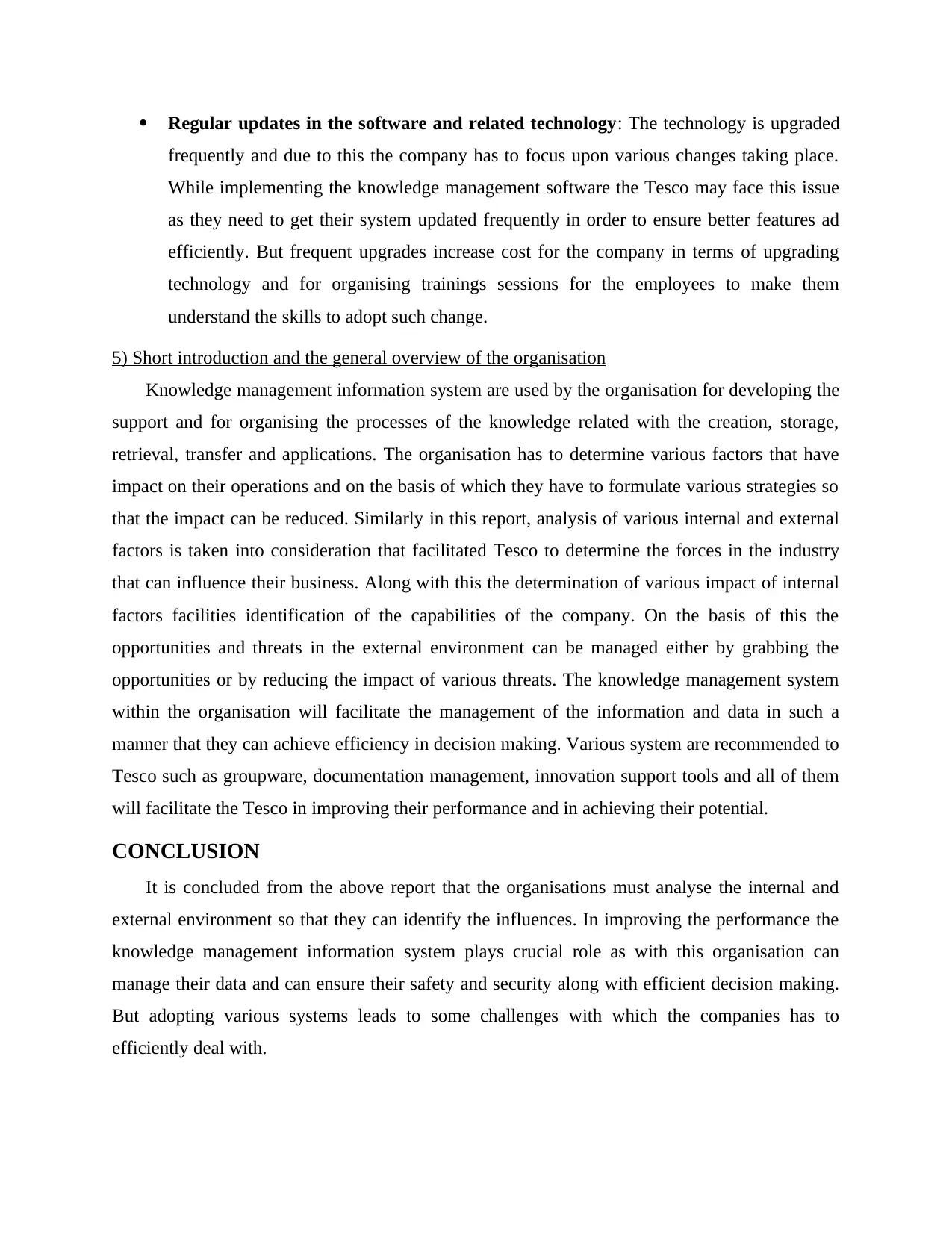
Regular updates in the software and related technology: The technology is upgraded
frequently and due to this the company has to focus upon various changes taking place.
While implementing the knowledge management software the Tesco may face this issue
as they need to get their system updated frequently in order to ensure better features ad
efficiently. But frequent upgrades increase cost for the company in terms of upgrading
technology and for organising trainings sessions for the employees to make them
understand the skills to adopt such change.
5) Short introduction and the general overview of the organisation
Knowledge management information system are used by the organisation for developing the
support and for organising the processes of the knowledge related with the creation, storage,
retrieval, transfer and applications. The organisation has to determine various factors that have
impact on their operations and on the basis of which they have to formulate various strategies so
that the impact can be reduced. Similarly in this report, analysis of various internal and external
factors is taken into consideration that facilitated Tesco to determine the forces in the industry
that can influence their business. Along with this the determination of various impact of internal
factors facilities identification of the capabilities of the company. On the basis of this the
opportunities and threats in the external environment can be managed either by grabbing the
opportunities or by reducing the impact of various threats. The knowledge management system
within the organisation will facilitate the management of the information and data in such a
manner that they can achieve efficiency in decision making. Various system are recommended to
Tesco such as groupware, documentation management, innovation support tools and all of them
will facilitate the Tesco in improving their performance and in achieving their potential.
CONCLUSION
It is concluded from the above report that the organisations must analyse the internal and
external environment so that they can identify the influences. In improving the performance the
knowledge management information system plays crucial role as with this organisation can
manage their data and can ensure their safety and security along with efficient decision making.
But adopting various systems leads to some challenges with which the companies has to
efficiently deal with.
frequently and due to this the company has to focus upon various changes taking place.
While implementing the knowledge management software the Tesco may face this issue
as they need to get their system updated frequently in order to ensure better features ad
efficiently. But frequent upgrades increase cost for the company in terms of upgrading
technology and for organising trainings sessions for the employees to make them
understand the skills to adopt such change.
5) Short introduction and the general overview of the organisation
Knowledge management information system are used by the organisation for developing the
support and for organising the processes of the knowledge related with the creation, storage,
retrieval, transfer and applications. The organisation has to determine various factors that have
impact on their operations and on the basis of which they have to formulate various strategies so
that the impact can be reduced. Similarly in this report, analysis of various internal and external
factors is taken into consideration that facilitated Tesco to determine the forces in the industry
that can influence their business. Along with this the determination of various impact of internal
factors facilities identification of the capabilities of the company. On the basis of this the
opportunities and threats in the external environment can be managed either by grabbing the
opportunities or by reducing the impact of various threats. The knowledge management system
within the organisation will facilitate the management of the information and data in such a
manner that they can achieve efficiency in decision making. Various system are recommended to
Tesco such as groupware, documentation management, innovation support tools and all of them
will facilitate the Tesco in improving their performance and in achieving their potential.
CONCLUSION
It is concluded from the above report that the organisations must analyse the internal and
external environment so that they can identify the influences. In improving the performance the
knowledge management information system plays crucial role as with this organisation can
manage their data and can ensure their safety and security along with efficient decision making.
But adopting various systems leads to some challenges with which the companies has to
efficiently deal with.

REFERENCES
Books & Journals
Au, C.H. and Fung, W.S., 2019. Integrating knowledge management into information security:
From audit to practice. International Journal of Knowledge Management
(IJKM). 15(1). pp.37-52.
Bazan, P. and Estevez, E., 2019. Social business process management. Business Process
Management Journal.
Cabitza, F., Locoro, A., Ravarini, A. and Satta, V., 2016. More time for the doing, having made
the thinking 3D printing for knowledge circulation in healthcare. In 8th International
Joint Conference on Knowledge Discovery, Knowledge Engineering and Knowledge
Management, IC3K 2016 (pp. 289-298). SciTePress.
Cai, H., Xu, B., Jiang, L. and Vasilakos, A.V., 2016. IoT-based big data storage systems in cloud
computing: perspectives and challenges. IEEE Internet of Things Journal, 4(1), pp.75-
87.
Dalkir, K., 2017. Knowledge management in theory and practice. MIT press.
Hislop, D., Bosua, R. and Helms, R., 2018. Knowledge management in organizations: A critical
introduction. Oxford University Press.
Hwang, Y., Lin, H. and Shin, D., 2018. Knowledge system commitment and knowledge sharing
intention: The role of personal information management motivation. International
Journal of Information Management. 39. pp.220-227.
Karamitri, I., Talias, M.A. and Bellali, T., 2017. Knowledge management practices in healthcare
settings: a systematic review. The International journal of health planning and
management. 32(1). pp.4-18.
Martin, W.J., 2017. The global information society. Taylor & Francis.
Massaro, M., and et. al., 2016. Knowledge management in small and medium enterprises: a
structured literature review. Journal of Knowledge Management.
Syed, J., and et. al., 2018. The Palgrave handbook of knowledge management. Palgrave
Macmillan.
Inkinen, H., 2016. Review of empirical research on knowledge management practices and firm
performance. Journal of knowledge management.
Books & Journals
Au, C.H. and Fung, W.S., 2019. Integrating knowledge management into information security:
From audit to practice. International Journal of Knowledge Management
(IJKM). 15(1). pp.37-52.
Bazan, P. and Estevez, E., 2019. Social business process management. Business Process
Management Journal.
Cabitza, F., Locoro, A., Ravarini, A. and Satta, V., 2016. More time for the doing, having made
the thinking 3D printing for knowledge circulation in healthcare. In 8th International
Joint Conference on Knowledge Discovery, Knowledge Engineering and Knowledge
Management, IC3K 2016 (pp. 289-298). SciTePress.
Cai, H., Xu, B., Jiang, L. and Vasilakos, A.V., 2016. IoT-based big data storage systems in cloud
computing: perspectives and challenges. IEEE Internet of Things Journal, 4(1), pp.75-
87.
Dalkir, K., 2017. Knowledge management in theory and practice. MIT press.
Hislop, D., Bosua, R. and Helms, R., 2018. Knowledge management in organizations: A critical
introduction. Oxford University Press.
Hwang, Y., Lin, H. and Shin, D., 2018. Knowledge system commitment and knowledge sharing
intention: The role of personal information management motivation. International
Journal of Information Management. 39. pp.220-227.
Karamitri, I., Talias, M.A. and Bellali, T., 2017. Knowledge management practices in healthcare
settings: a systematic review. The International journal of health planning and
management. 32(1). pp.4-18.
Martin, W.J., 2017. The global information society. Taylor & Francis.
Massaro, M., and et. al., 2016. Knowledge management in small and medium enterprises: a
structured literature review. Journal of Knowledge Management.
Syed, J., and et. al., 2018. The Palgrave handbook of knowledge management. Palgrave
Macmillan.
Inkinen, H., 2016. Review of empirical research on knowledge management practices and firm
performance. Journal of knowledge management.
⊘ This is a preview!⊘
Do you want full access?
Subscribe today to unlock all pages.

Trusted by 1+ million students worldwide
1 out of 12
Related Documents
Your All-in-One AI-Powered Toolkit for Academic Success.
+13062052269
info@desklib.com
Available 24*7 on WhatsApp / Email
![[object Object]](/_next/static/media/star-bottom.7253800d.svg)
Unlock your academic potential
Copyright © 2020–2025 A2Z Services. All Rights Reserved. Developed and managed by ZUCOL.





